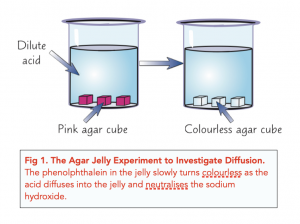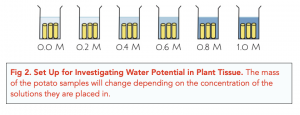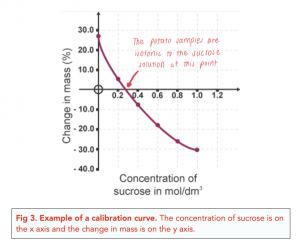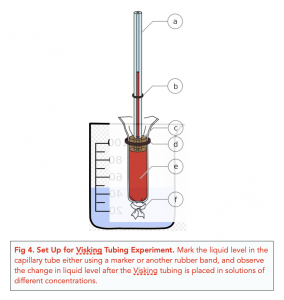Investigating Transport Across Membranes (A-level Biology)
Investigating Transport Across Membranes
Investigating Diffusion
We can investigate how diffusion occurs in biological cells by using cubes of agar jelly. The basic concept of this experiment is outlined below:
- The agar jelly contains a pH indicator. We can make up agar jelly with an alkaline solution (e.g. sodium hydroxide) and add a few drops of phenolphthalein to it before the jelly sets. Phenolphthalein is a pH indicator which turns pink in the presence of alkaline solutions, thus, the jelly will have a bright pink colour.
- The agar jelly is placed in an acidic solution. Once the jelly has set, we can cut it up into cubes and place it in an acidic solution, such as dilute hydrochloric acid.
- The agar jelly is neutralised by the diffusion of the acid. The acidic solution will slowly diffuse into the agar jelly and neutralise the alkaline solution. As it does, the jelly will lose its pink colour and become colourless, as phenolphthalein turns colourless in non-alkaline environments.

We can alter different parts of this experiment to model how different factors affect the rate of diffusion.
Investigating the effects of surface area on diffusion
- Cut the agar jelly into different sized cubes to investigate the effects of surface area. Cut the jelly into cubes of different sizes and work out each cube’s surface area to volume ratio. For example, a cube with 2cm edges will have a surface area to volume ratio of 3:1.
- Place the cubes in the same volume and concentration of acid. Put the cubes into containers which hold the same volume and concentration of hydrochloric acid. Then measure the time it takes for the different cubes to go colourless.
- The cube with the largest surface area: volume ratio will go colourless the quickest. The cube with the largest surface area: volume ratio has the greatest amount of space available for the hydrochloric acid to diffuse into the jelly so it will be neutralised the fastest.
Investigating the effects of concentration on diffusion
- Place the agar jelly cubes in different concentrations of acid. Cut the agar jelly into equal sized cubes and put them in different containers, each with a different concentration of hydrochloric acid. Measure the time it takes for the different cubes to go colourless.
- The cube placed in the highest concentration of acid will go colourless the quickest. The cube placed in the container with the highest concentration will have the greatest concentration of acid being diffused into the jelly per minute. As such, it will go colourless the quickest.
Investigating the effects of temperature on diffusion
- Place the agar jelly cubes in different temperatures. Cut the agar jelly into equal sized cubes and put them in different containers, each with the same concentration of hydrochloric acid. Put the containers in water baths heated to different temperatures. Be careful not to heat the water baths over 65° as the agar jelly will melt.
- The cube placed in the highest temperature of acid will go colourless the quickest. As high temperatures speed up the rate of diffusion, the cube in the hottest container will be neutralised the quickest.
Investigating Osmosis
Osmosis is the movement of water molecules from an area of high water potential to an of low water potential by osmosis. Water potential is determined by the concentration of solutes in the solutions on either side of the cell membrane.
Investigations using plant tissue
This experiment involves placing plant tissue, e.g. potato cylinders, in varying concentrations of sucrose solutions to determine the water potential of the plant tissues.
- Prepare the different concentrations of sucrose solutions. Using distilled water and 1M sucrose solution, prepare a series of dilutions such that you now have 0.0, 0.2, 0.4, 0.6, 0.8 and 1.0M sucrose. Place 5cm3 of each dilution into separate beakers.
- Prepare equal sized pieces of potato chips. Using a cork borer, cut out 18 pieces of potato chips, all of equal sizes.
- Weigh the mass of the potato chips. Dry the potato chips gently with a paper towel. Divide them into groups of three and weigh each group.
- Place each group of potato chips in each solution. The potato chips should be left in the solutions for a minimum of 20 minutes. All groups should be left in the solution for the same amount of time.

-
- The potato samples in the dilute solutions will have a net increase in mass – the water potential is greater in the potato than in the sucrose solution, so water moves into the potato samples via osmosis.
- The potato samples in the concentrated solutions will have a net decrease in mass – the water potential is lower in the potato than in the sucrose solution, so water moves out of the potato samples via osmosis.

Investigations using Visking tubing
Visking tubing is an artificial membrane that is selectively permeable as it has many microscopic pores. This allows smaller molecules such as water and glucose to pass through it, while larger molecules such as starch and sucrose are unable to cross the membrane.
- Prepare three equal-sized pieces of Visking tubings. Run the tubing under tap water to soften it and knot each tubing on one end to create a bag.
- Place a rubber bung at the open end of the Visking tubing. Find rubber bungs with an opening in the centre that will fit the open end of the Visking tubing. Then seal the tubing using the bung and fix it in place using a rubber band.
- Prepare sucrose solutions with concentrations of 0.5M and 1.0M. You may wish to add a food dye to the 0.5M solution so that it is easier to see later on.
- Pipette in the 0.5M sucrose solution. Using a pipette or a syringe, fill each tubing through the opening of the rubber bung with the 0.5M sucrose solution. Make sure it is filled completely to the brim with no air bubbles.
- Insert capillary tubes into each of the tubings. Insert a capillary tube through the rubber bung’s opening. Mark the level at which the sucrose solution has risen to in the capillary tube.
- Place each Visking tubing into containers of different solutions. Prepare three beakers, each containing distilled water, 0.5M sucrose, and 1.0M sucrose. Place each Visking tubing into each of the beakers and leave them in for the same amount of time.
- Measure the change in liquid level. Mark the new liquid level on the capillary tube before removing the Visking tubing from its beaker. Measure the change in the liquid level. Overall:
-
- The liquid level of the Visking tubing placed in distilled water will have risen as the sucrose solution in the tubing is hypertonic to the water i.e. the sucrose is more concentrated. Thus, there is net movement of water into the Visking tubing via osmosis.
- The liquid level of the Visking tubing placed in 0.5M sucrose will remain the same as the solution inside the tubing and outside the tubing are isotonic i.e. the solutions are the same concentration.
- The liquid level of the Visking tubing placed in 1.0M sucrose will have decreased as the solution inside the tubing is hypotonic to the solution outside the tubing i.e. the solution inside the tubing is less concentrated.

Transport across membranes is the movement of substances such as ions, molecules, and fluids from one side of a biological membrane to the other. This process is crucial for maintaining cellular homeostasis and allowing cells to exchange materials with their environment.
Investigating transport across membranes is important because it helps us understand the mechanisms by which cells regulate the flow of substances in and out of the cell. This is essential for understanding cellular processes such as metabolic reactions, waste removal, and communication between cells.
There are several methods used to investigate transport across membranes, including:
Diffusion experiments to study the movement of substances through the lipid bilayer
Osmosis experiments to study the movement of water across a semi-permeable membrane
Active transport experiments to study the movement of substances against a concentration gradient with the use of energy
Electrochemical experiments to study the movement of ions across the membrane
Factors that can affect transport across membranes include the size of the substance being transported, the charge of the substance, the concentration gradient, and the presence of specific transport proteins.
Transport across membranes can be measured in a variety of ways, including measuring changes in substance concentration, changes in electrical potential, and changes in fluid movement.
The limitations of investigating transport across membranes include the difficulty of obtaining pure and intact biological membranes, the potential for damage to the membrane during experimentation, and the limitations of experimental techniques.
In A-Level Biology, knowledge of transport across membranes can be applied to understand cellular processes such as the movement of nutrients and waste, the regulation of cell volume, and the communication between cells. This knowledge is also important for understanding diseases and disorders related to the malfunction of transport processes, such as cystic fibrosis and diabetes.





Still got a question? Leave a comment
Leave a comment